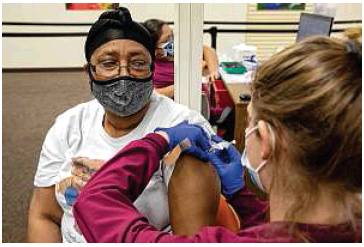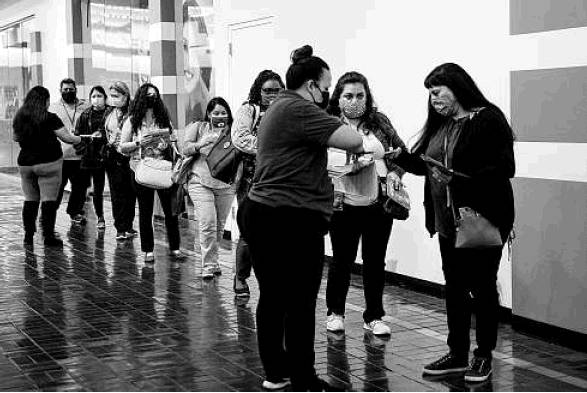Texas minorities’ vaccination rates below those of whites
By Cayla Harris and Raga Justin AUSTIN BUREAU
A month and a half after Texas officials began requiring COVID-19 vaccine providers to track their patients’ race and ethnicity, new state data shows that Hispanic and Black Texans — who have been most severely affected by the pandemic — are receiving the vaccine at disproportionately lower rates than white people.
The numbers are both promising and concerning for government officials and advocates — relieved that they finally have firm data to evaluate and troubled that the statistics appear to confirm fears that the state is not reaching communities of color in its rapidly expanding vaccine rollout. All Texans over age 15 became eligible a week ago.
Federally operated mass vaccination sites in major metropolitan areas have shown some success in getting more shots to Black and Latino Texans, but even those numbers are not enough to allay equity concerns that public health officials and advocates have been raising for months. They are urging local and state leaders to partner with community activists and ramp up direct outreach to high-risk Texans.
Statewide, Latinos have accounted for nearly half of all COVID-19 deaths, despite making up 36 percent of Texas’ adult population. Yet since the state began mandating demographic reporting on vaccine recipients in early February, Hispanic Texans have accounted for 29 percent of first doses administered.
Bexar County has made more progress, with Hispanics accounting for about 48 percent of all vaccinations, according to Metropolitan Health District figures in late March. But the rate still is disproportionately low for the county, which is 60 percent Hispanic.
Nationally, Black and Hispanic people are about four times as likely as white people to be hospitalized with COVID-19 and about three times as likely to die from the virus, according to the Centers for Disease Control and Prevention. Between Feb. 4 and March 20, 8 percent of first doses went to Black Texans; they make up12 percent of the state’s adult population.
“From an equity standpoint, you have to ask yourself why some groups are getting the vaccine and others aren’t,” said Melissa Dupont-Reyes, an assistant professor in epidemiology and biostatistics at the Texas A&M School of Public Health. “These questions are important.”
Demographic data also shows that younger Texans are far more racially and ethnically diverse than the state’s older residents. As the state opens up eligibility to people under 50, health officials expect that the vaccine numbers will become more equitable — though the expanded access is certainly not a cure-all on its own.
Targeting high-risk areas
The equity concerns have existed since Texas began administering first doses in mid-December. State officials initially distributed the vaccine in small quantities to a large number of vaccine providers before switching to a “hub” strategy and sending thousands of doses to a handful of large-scale providers.
Then came the three mass vaccination sites established by the Federal Emergency Management Agency that promised to reach underserved communities, with up to 6,000 inoculations a day.
Those federal sites — one in Houston and two in the Dallas-Fort Worth area — finished their first round of vaccinations last month and are now moving on to second doses. Early results suggest better outreach to Black and Latino communities than statewide averages, but comparisons to local demographic data paint a different picture.
At NRG Park’s mass site in Houston, for example, 34 percent of recipients have been Hispanic, 31 percent white, 24 percent Black and 7 percent Asian, local officials said.
The numbers are inconclusive: Hispanics, who make up 44 percent of residents in Harris County, are underrepresented, while Black vaccine recipients make up a slightly higher percentage than their population share in the county, which is 19 percent, according to census data.
Stephen Williams, the director of Houston’s health department, said the city’s FEMA hub numbers represent an intentional, concerted effort by local officials to reach high-risk Texans. City officials used vulnerability categories from the CDC to target the ZIP codes in most need of the vaccine, he said.
“The responsibility, I think, is on all of us to come together and develop a strategy to ensure that access and equity occurs in these vulnerable ZIP codes,” Williams said.
In Houston, officials have rolled out ad campaigns targeting communities of color, launching radio and TV ads in Spanish and English. Williams also pointed to recent outreach at Black churches and said the city partnered with a Vietnamese doctor’s group to vaccinate more Asian Americans.
But there’s a long road ahead even with those efforts. A Hearst Newspapers analysis of state COVID vaccine data found that 17 of the 20 ZIP codes in Harris County with the lowest percentage of people who have received at least one vaccine dose were majority Latino; 18 had median incomes below the county average.
“It’s going to take multiple strategies to reach people who lack access to or are traditionally under-served by health care,” said Chris Van Deusen, a spokesman for the state health department. “For example, working with organizations and trusted leaders in those communities, getting vaccine to providers in underserved areas, holding mobile or other vaccine clinics in those neighborhoods.”
Data collection problems
In Arlington, vaccine recipients at the FEMA site have been 42 percent white; 21 percent Hispanic; 10 percent Black; and 8 percent Asian, according to data provided by local officials. There, 12 percent of recipients declined to provide information on their race, and 6 percent are listed as unknown, making it difficult to draw conclusions.
Dallas County declined to provide demographic data for its FEMA site. Houston and Arlington provided their data through March 10; the sites opened in late February.
In those instances, a lack of data makes it difficult to determine the extent of the racial disparities. In the early days of Texas’ vaccine rollout, that was officials’ and advocates’ main concern — by late January, race and ethnicity data were missing for nearly half of vaccine recipients.
Six weeks after Texas mandated that providers report that data, the state is missing that information for only about 16 percent of people. To date, more than 6.2 million Texans have received at least one dose of the vaccine, and 3.1 million people are fully inoculated.
“We have more work to do as a society to make sure the vaccine is being distributed equitably,” Van Deusen said. “Remember, too, that we’re still relatively early in the process.”
Still, some officials are concerned that the large-scale sites, including FEMA hubs, may not be achieving their stated goals.
State Sen. Borris Miles, D-Houston, who confronted state leaders about inequities in the vaccine rollout at a Senate hearing last month, said the mass vaccination sites are too often out of reach for Texans who can’t access online sign-up sheets or lack transportation. He suggests hosting vaccine events at nontraditional sites, such as churches and community centers, and sending mobile vaccination clinics into urban areas.
“The data the state is collecting now allows us to identify areas and demographic groups that are lagging in their vaccination rates,” Miles said in an email. “We must put that data to use and send the vaccine to those communities that need it.”
‘More working together’
Outside of the federal sites, the state’s vaccine rollout so far has relied on partnerships with major hospital systems in metropolitan areas — an approach that also doesn’t account for access barriers in rural and low-income communities, said Allison Winnike, president and CEO of the Immunization Partnership, an advocacy group.
“If you send thousands of vaccines to a big hub in Houston or San Antonio, sure, a lot of people will get vaccinated,” Winnike said. “But the socially vulnerable people in those areas may not have the transportation or even a flexible schedule.”
Those areas are also typically pharmacy deserts, making the large quantity of vaccines allocated to CVS, Walgreens and H-E-B inaccessible to hundreds of thousands of Texans, said Jaeson Fournier, CEO of CommUnityCare Health Centers, a vaccine provider in Austin. The organization has relied on multilanguage text services and targeted messaging efforts to connect with vulnerable patients in the city’s hardest-hit ZIP codes, he said.
The center has administered thousands of COVID vaccines over the past several weeks. Preliminary data shows that roughly 68 percent of vaccine recipients were people of color, he said.
“There should be an allocation that is more favored toward entities that are more able to provide the vaccine to underserved communities,” Fournier said.
Experts hope direct outreach can ease vaccine hesitancy in communities of color. National surveys have indicated that Black and Hispanic people are less likely than white people to pursue inoculation — a symptom of the mistrust in government and health officials that stems from a long history of systemic racism and medical abuse.
“People aren’t saying they’re never going to get the vaccine. But they are saying, ‘I want to wait a little bit,’” said Catherine Troisi, an infectious disease epidemiologist at UTHealth School of Public Health.
Texas officials say they will focus on reaching minority communities in the coming weeks. The state is researching vaccine hesitancy, said Van Deusen, the health department spokesman, “so that we’ll have strategies and material that will speak to a variety of Texans.”
“Bottom line is that there’s not a single, easy solution to reaching hard-to-reach groups — it’s going to take all of these approaches and more working together,” he said. cayla.harris@express-news.com raga.justin@chron.com

